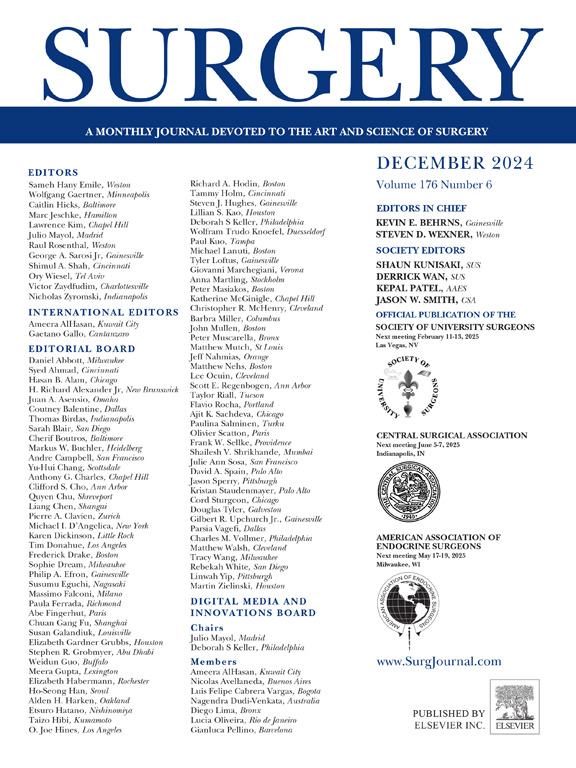吡咯喹啉醌(PQQ)对小鼠皮肤伤口愈合的影响
IF 2.7
2区 医学
Q1 SURGERY
引用次数: 0
摘要
目的:伤口愈合是一个动态的过程,它开始于皮肤正常解剖结构的破坏。本研究评价了吡咯喹啉醌对小鼠皮肤损伤的治疗作用。方法雄性小鼠36只,随机分为3组:(1)假手术组,创面不处理;(2)大豆油,大豆油局部涂抹创面9天;(3)吡咯喹啉醌组,吡咯喹啉醌溶解于大豆油中,局部应用。每组4只小鼠造切口创面模型进行生物力学试验。第7和14天分别进行苏木精和伊红、马松三色、caspase 3、血管内皮生长因子和肿瘤生长因子β、氧化应激生物标志物的免疫组化染色以及肿瘤坏死因子α和核因子κ B的Western blot检测。伤后第10天评估生物力学参数。结果吡洛喹啉醌可显著减少创面面积。治疗组丙二醛和总氧化水平显著降低,总抗氧化能力显著提高。吡咯喹啉醌组的羟脯氨酸水平明显高于其他2组。Western blot检测,治疗组肿瘤坏死因子α明显降低。组织病理学评估证实,吡咯喹啉醌组伤口愈合改善,caspase 3和肿瘤生长因子β的表达降低。吡咯喹啉醌组血管内皮生长因子表达在第7天升高,第14天降低。生物力学参数,包括应变、极限强度和最大能量储存均有显著改善。结论吡咯喹啉醌具有促进小鼠创面愈合的作用。本文章由计算机程序翻译,如有差异,请以英文原文为准。

Effects of pyrroloquinoline quinone (PQQ) on skin wound healing in mice
Objective
Wound healing is a dynamic process that begins following the destruction of the skin's normal anatomy. This study evaluated effects of pyrroloquinoline quinone on skin wounds in mice.
Methods
Thirty-six male mice were randomly divided in to 3 groups: (1) Sham group, where wounds were created but no treatment was administered; (2) Soybean oil, where soybean oil was applied topically to wounds for 9 days; and (3) pyrroloquinoline quinone group, where pyrroloquinoline quinone dissolved in soybean oil was applied topically. Four mice per group were used in an incisional wound model for biomechanical testing. Hematoxylin and eosin, Masson trichrome, immunohistochemical staining of caspase 3, vascular endothelial growth factor and tumor growth factor beta, oxidative stress biomarkers, and Western blot assay for tumor necrosis factor alpha and nuclear factor kappa B were performed on days 7 and 14. Biomechanical parameters were evaluated on day 10 post wounding.
Results
Pyrroloquinoline quinone significantly reduced the wound area. In the treatment group, malondialdehyde and total oxidant status significantly reduced and total antioxidant capacity was increased compared with other groups. Levels of hydroxyproline was significantly higher in the pyrroloquinoline quinone group in comparison to 2 other groups. In Western blot assay, tumor necrosis factor alpha significantly reduced in the treatment group. Histopathologic evaluation confirmed improved wound healing in the pyrroloquinoline quinone group, with reduced expression of caspase 3 and tumor growth factor beta. Vascular endothelial growth factor expression increased on day 7 but decreased on day 14 in the pyrroloquinoline quinone group. Biomechanical parameters including, strain, ultimate strength, and maximum energy stored, showed significant improvements.
Conclusion
These findings suggested that pyrroloquinoline quinone may accelerate wound healing in mice.
求助全文
通过发布文献求助,成功后即可免费获取论文全文。
去求助
来源期刊

Surgery
医学-外科
CiteScore
5.40
自引率
5.30%
发文量
687
审稿时长
64 days
期刊介绍:
For 66 years, Surgery has published practical, authoritative information about procedures, clinical advances, and major trends shaping general surgery. Each issue features original scientific contributions and clinical reports. Peer-reviewed articles cover topics in oncology, trauma, gastrointestinal, vascular, and transplantation surgery. The journal also publishes papers from the meetings of its sponsoring societies, the Society of University Surgeons, the Central Surgical Association, and the American Association of Endocrine Surgeons.
 求助内容:
求助内容: 应助结果提醒方式:
应助结果提醒方式:


